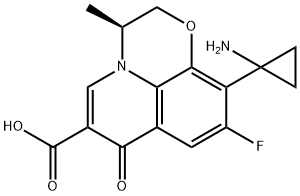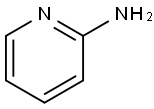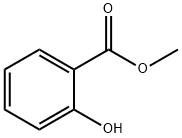Pazufloxacin , 98% , 127045-41-4
CAS NO.:127045-41-4
Empirical Formula: C16H15FN2O4
Molecular Weight: 318.3
MDL number: MFCD00865012
EINECS: 635-036-1
| Pack Size | Price | Stock | Quantity |
| 100mg | RMB2080.00 | In Stock |
|
| 500mg | RMB9968.00 | In Stock |
|
| others | Enquire |
PRODUCT Properties
| Melting point: | 269-271°C |
| alpha | D25 -88.0° (c = 0.5 in 0.05N aq NaOH) |
| Boiling point: | 531.5±50.0 °C(Predicted) |
| Density | 1.56 |
| storage temp. | 2-8°C |
| solubility | Aqueous Base (Slightly, Sonicated), DMSO (Slightly, Heated), Methanol (Slightly) |
| pka | 5.05±0.40(Predicted) |
| color | Off-White to Pale Yellow |
| CAS DataBase Reference | 127045-41-4(CAS DataBase Reference) |
Description and Uses
Pazufloxacin is a novel quinolone marketed for the treatment of bacterial infections in Japan. This tricyclic fluoro-quinolone can be synthesized in 11 steps from commercially available 2,3,4,5tetrafluorobenzoic acid. The cyclopropyl substituent is first introduced in 6 steps including 4-F-substitution with tert-butylcyanoacetate, decarboxylation, aa alkylation with 1 ,Zdibromoethane, partial nitrile hydrolysis and Hoffmann-rearrangement. The pyridoxazine ring is then introduced in 5 steps including 6-ketoester formation and pryridoxazine annulation. Pazufloxacin displays a broad spectrum activity against Grampositive and Gram-negative bacteria, although it is less active that ciprofloxacin against pneumococci and is not active against ciprofloxacin-resistant isolates. In patients with gonococcal urethritis a high prevalence of fluoroquinolone-resistant N. gonorrhoeae isolates with the Ser-91-to-Phe mutation in GyrA was observed. However, good clinical responses have been seen in clinical trials of patients with urinary tract infections and to a lesser extent with respiratory tract infections. Pazufloxacin is mainly excreted in urine with a short half-life (2-2.5 h). It has a phototoxicity equal to that of ciprofloxacin and its adverse effect profile resembles that of other quinolones.
Pazufloxacin is a potential antimicrobial and/or antiviral agent.
Safety
| Symbol(GHS) |  GHS07 |
| Signal word | Warning |
| Hazard statements | H302+H312+H332 |
| Precautionary statements | P261-P264-P280-P301+P312-P302+P352+P312-P304+P340+P312 |
| Hazard Codes | Xn,C,F |
| Risk Statements | 20/21/22-34-11 |
| Safety Statements | 36/37-45-36/37/39-26-16 |
| WGK Germany | 3 |
| RTECS | UU8815300 |
| Toxicity | LD50 i.v. in male mice: >500 mg/kg (Todo) |




